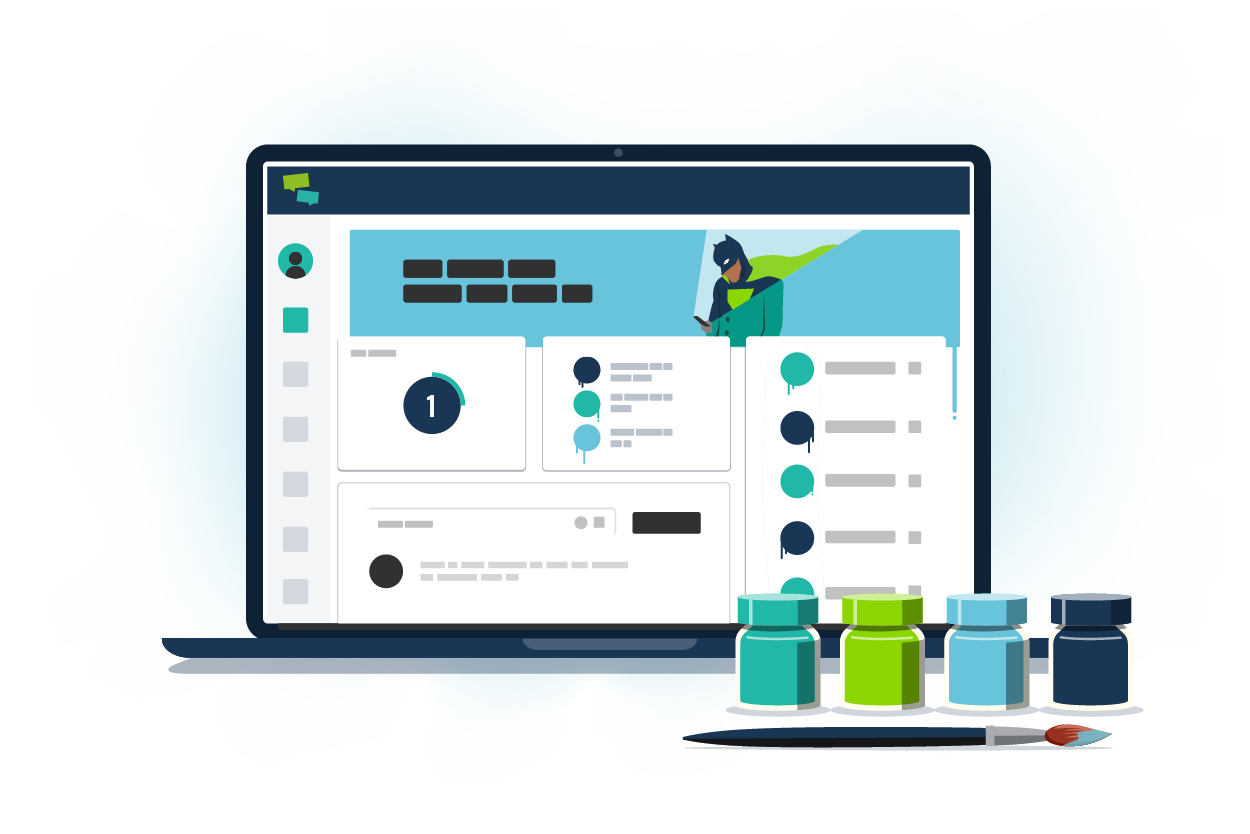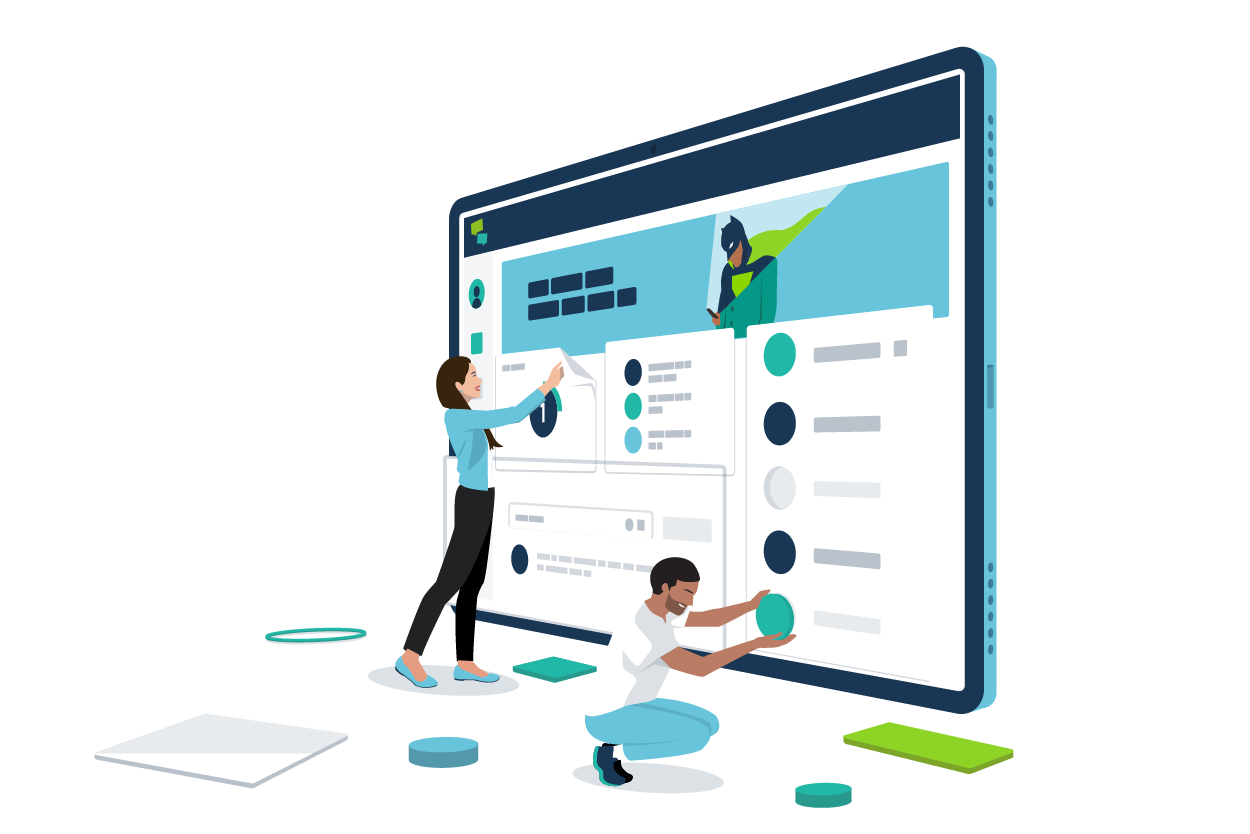
Why do certain products capture our attention whilst others fade into the background? What fosters unwavering loyalty to certain companies? The answer is simple: it’s all about branding. Your company’s identity matters. And your learning brand matters too.
As Stephen King (not that one!) puts it, ‘a product can be quickly outdated, but a successful brand is timeless’.
Indeed, a strong brand goes a long way. It drives recognition, awareness, loyalty and ultimately, engagement. Harnessing these dynamics in the realm of organisational learning and development helps to improve both uptake and outcomes.
Unfortunately, brands don’t magically materialise out of thin air. You’ll need to intentionally cultivate your new identity. Following this, you’ll need to exercise unwavering consistency. Thankfully, you don’t need to be a marketing genius to pull this feat off.
We’ve created an 8-step guide to building your own learning brand. Along the way, we’ll unravel the benefits of branding and the characteristics of a standout brand. Your identity crisis ends here. Let’s get started!
What is a Brand?
A brand serves as a company’s identity, representing its outward expression to the world. In the constant barrage of brands we encounter daily, the ones that leave a lasting impression are those that actively inspire us to connect and engage.
This can be the difference between a chain of fast food eateries and a colossal $23 billion burger empire. It’s also the reason why you might pick a familiar product over something new and unknown. Brands make us feel something and create advocacy.
Brands are so much more than a logo or a set of colours and fonts. They encompass the overall perception and reputation of a company in the minds of consumers. This includes your organisation’s values, mission and personality.
Branding is the process of creating and managing these associations in order to build a positive organisational image. Elements of the brand can include the name, logo, tagline, colours, fonts and style of communication.
What is a Learning Brand?
Your learning brand is your organisation’s learning and development identity. It’s the sum of all your training touchpoints, learning experiences and communication output. These are all opportunities for you to leave a meaningful impression.
Whether or not you’ve been working on your learning brand, it still exists. As branding expert David Brier puts it, ‘If you don’t give the market the story to talk about, they’ll define your brand’s story for you.’
Your learners will have already preconceptions about what your upcoming training initiatives might entail — be they good or bad. Regardless, it’s now up to you to grab the reins. After all, your learning brand impacts and informs everything you do as a L&D team. This includes your:
- Training content
- Learning environment and platforms
- Badges, certificates and rewards
- Promotional material
Why Build a Learning Brand?

L&D teams are locked in a constant battle to capture the hearts and minds of their employees. After all, if they can’t engage their learners, they won’t change their behaviour or improve performance.
Without a clearly defined learning identity, or brand, this battle could be over before it’s even begun. With this in mind, here are five compelling reasons why you should start intentionally building your learning brand today.
1. Improved Awareness
Before you can engage your learners, you first need their attention. Unfortunately, many learning programmes fall flat due to a simple lack of awareness. If your learners don’t know your courses exist, then how are they supposed to access them?
Thankfully, a strong learning brand will drive familiarity and recognition, leading to increased awareness and uptake.
2. Increased Trust
Your learners have to contend with several different demands on their time. A robust learning brand helps to cut through the noise by radiating professionalism and cultivating credibility.
This serves as a confidence-boosting signal that demonstrates your organisation’s commitment to high-quality learning experiences. As a result, your training will start to creep up your learners’ to-do lists.
3. A Sense of Belonging
Your learning brand has the power to establish a profound emotional connection with your audience. If you’re consistently sparking joy, then your learners are likely to feel a sense of pride and belonging when they consider their relationship to your brand.
This consistency generates loyalty whilst also helping to create a seamless and streamlined experience for your learners.
4. Engagement Overload
Here’s perhaps the biggest and best benefit. Learning brands help you to build an actively engaged audience.
When your learners have positive experiences with one training initiative, they are more likely to engage with subsequent programmes under the same brand. They are also more likely to do so with enthusiasm.
In turn, better engagement leads to an impressive bounty of benefits.
5. Consistent Values
As a learning professional, you’re responsible for crafting training programmes that seamlessly align with the values and goals of your organisation.
By using consistent branding you can reinforce the vital connection between the learning experiences you deliver and the overarching mission of your company. This unified messaging imbues your content with a real sense of purpose.
As you can see, a strong brand is a competitive advantage — and you’re competing for your learners’ attention. There’s a reason why Apple customers are known for their fierce loyalty. It’s the same reason why we’re willing to pay more for a Starbucks coffee or a Rolex watch.
A commitment to quality and consistency can go a long way.
The Power of Branding
Still not convinced? Take a look at the research below, drawn from the realm of consumer marketing. Your audience may be choosing whether or not to engage, rather than making purchasing decisions, but the impact remains just as significant.
- Consumers are 2.5x more likely to purchase from brands they recognise.
- Consistent brand presentation can increase revenue by up to 23%.
- 64% of consumers consider brand reputation when making purchasing decisions.
- 55% of consumers are more likely to buy a product if they love a brand’s story.
- 81% of consumers agree that trust is a vital requirement for buying from a brand.
- 90% of snap judgments about products can be based on colour alone.
How to Build a Learning Brand
Now we know why it’s important to have a learning brand, it’s time to unleash your creativity. However, building a cohesive and recognisable identity requires careful thought and consideration. Here’s a step-by-step guide to get you started.
1. Define Your Objectives

Crafting something meaningful requires a clear understanding of your purpose. Before you get into the nitty gritty, you should start by clearly outlining the objectives of your learning and development initiatives.
This should be a statement of intent. Consider what you aim to achieve and how you want your learners to perceive you. This is your north star and your guiding light. Just make sure it aligns with the overarching goals of your organisation.
You can then elevate your efforts by documenting your brand’s mission, vision and values. These should have a clear link to your pre-set objectives. This will then serve as a roadmap, providing every current and future team member with a unified direction to follow.
2. Get to Know Your Audience

Next up, identify and understand your audience. These are the learners that will be engaging with your new brand. You’ll need to consider their preferences, motivations and challenges. This will help you to tailor your brand accordingly.
We recommend the two following exercises:
- Training Needs Analysis: By surveying and assessing your learners, you can identify the knowledge and skills gaps that your organisation needs to address. This, in turn, can help to set the focus for your learning brand.
- Learner Personas: You should also create a set of learner personas that represent your target audience. These are fictional representations of your real learners. They’re designed to help you to make better informed decisions.
3. Develop Your Strategy

It’s time to define your brand’s personality. Think about how you want your learners to react every time they interact with your training programmes or your brand overall. Let this vision steer the positioning of your brand and shape your unique value proposition.
This will help you to formulate your messaging and tone of voice. Your aim should be to communicate the essence of your L&D initiatives, highlight the benefits of your training and build unwavering levels of engagement.
4. Establish Your Visual Identity

Now for the fun part. Your brand needs its own visual identity. These are the design assets and rules that help to distinguish your brand in the minds of your learners.
Your visual identity should be tied to your organisational brand, whilst maintaining unique characteristics. If you don’t have access to an in-house design team, you may need some outside help with this step.
To keep things simple, we’d recommend starting with the following assets.
- Logo: Your logo is the graphic or symbol that serves as the primary visual representation of your brand. Take your time with this one, as it will be placed on every brand touchpoint.
- Colour Palette: Next up, select a set of colours that will be associated with your brand. Remember, colours convey specific emotions, establish a mood and contribute to overall brand recognition.
- Typography: Select the fonts, styles and treatments you will use across your brand’s written content. Different fonts have a different feel. Will your brand be better served by Helvetica or Comic Sans?
- Visual Elements: Consider what types of imagery and photography you will use across your brand (both in training content and promotional materials). Will you lean on stock imagery or use a different approach?
- Design Principles: Once you have a logo, colour palette and fonts, you’ll need to establish some consistent design principles. This should include how they are arranged, spacing rules and overall aesthetic choices.
The above items may only scratch the surface. In some cases, you may also need to consider iconography, packaging design and other graphic elements. Either way, ensure consistency across all touchpoints to help enhance brand recognition.
5. Create Brand Guidelines

Once you’ve established your brand’s visual identity, you’ll then need to enshrine it in a set of brand guidelines. This is a document that specifies how your brand should be utilised and applied.
You’ll want to include rules for logo usage, colour specifications (RGB and Hex Codes) and clear guidelines for your written and visual content. This document should be simple enough to follow for both existing and new team-members.
It’s also a good opportunity for you to build a story around your brand. Why not craft a compelling narrative that helps to communicate the journey and purpose of your L&D initiatives?
6. Seek Out Feedback

You’re almost ready to push that big green ‘Go’ button. But, before you do that, why not solicit feedback on your brand from your key stakeholders, internal teams and learners themselves? This will give you a 360-degree picture of your brand’s influence.
Create sample branded assets and mock-ups that you can share with your audience. Record their reaction via a survey or feedback form. You can then use this feedback to make adjustments and improvements as needed.
7. Roll-out Your Branding

The time has come. You’ve created and sense-checked your brand strategy and visual identity. Now you should apply your brand consistently across all touchpoints. This includes (but is not limited to) training materials, communication channels and online platforms.
Your brand should be present wherever and whenever you interact with your learners. Take particular care with well-trafficked training solutions, such as your learning management system and learning app. After all, consistency reinforces brand recognition.
8. Evolve and Adapt

By this stage, your audience is regularly interacting and engaging with your learning brand. If you’ve followed the previous steps, then you’ll be building recognition, trust and loyalty. However, you can’t afford to sit still if you’re seeking ongoing success.
Brands are dynamic and should evolve to stay relevant. Just look at the way these brands have changed over time. As such, you should regularly review your brand strategy and make adjustments based on changing organisational goals, industry trends and learner feedback.
Find Your Epic Meaning

Here at Growth Engineering, we’re epic meaning advocates. This is the sense of purpose that fuels our passion for a cause. It’s that feeling we get when we’re a part of something bigger than just ourselves.
Your brand is a powerful tool for generating epic meaning. After all, it’s the banner under which all your employees gather. If you’ve created a strong learning brand, then it should help to unite your audience and provide them with a clear purpose.
This can often be achieved by combining your brand with a narrative or theme and exploring novel forms of expression. We’ve seen customers get very creative with their digital learning platforms. Here are some tips to get you started.
- Don’t call your learning system, ‘The Academy’, or something bland and nondescript. Tie its name to your brand, narrative or theme. For instance, Flight Centre call their internal learning platform ‘Compass’, helping to highlight the joy of discovery.
- Use branded elements across your learning platform to bring this theme to life. You’ll have logos, banners, widgets and other visual assets that you can customise. Don’t forget to change platform terminology where relevant.
- Many learning systems (such as Growth Engineering LMS) let you customise their gamification features. For instance, you could change ‘Badges’ to ‘Trophies’ or ‘Experience Points’ to ‘Discovery Points’ and update any associated imagery.
In the search for epic meaning, there should be no limits on your creativity aside from those imposed by your brand. If you can successfully weave a captivating narrative or utilise a consistent theme, then you’re sure to delight your learners.
What Makes a Good Learning Brand?
Now that you’ve created your brand, it’s time to assess its potency. To do this, we’ll need to explore the qualities and characteristics of a good learning brand. Why not give the brand you’ve created a score in each area?
- Clarity & Consistency: Successful brands have a clear and distinct identity. They also maintain consistency across all touchpoints.
- Authenticity: Authentic brands are true to their values and mission. They align their actions with stated principles and objectives.
- Relevance: Effective brands understand their target audience and adapt and evolve in order to meet their needs.
- Differentiation: The best brands differentiate themselves by offering a unique value proposition and clear benefit statements.
- Emotional Connection: A good brand connects with its audience on an emotional level, creating positive feelings and a sense of loyalty.
- Adaptability: Brands that embrace innovation and are willing to change tend to be more resilient and able to stay ahead of the curve.
Final Word
As we’ve seen, strong brands have their own gravitational pull. They have an impact on awareness, recognition, behaviour and loyalty. Naturally enough, these are qualities that we’d all love to see associated with our learning programmes.
By following the outlined steps, from defining clear objectives to crafting a unique visual identity, you will lay the foundation for a learning brand that resonates with your audience. This resonance is sure to lead to engagement and impact.
Just remember, your learning brand is more than just a logo or a name. After all, your brand connects everything and everyone together and provides a sense of purpose. Without it, you’re just another learning programme. But with it, you’re something special.
Thank you for reading. Building a learning brand is just one strategy for engaging your learners. Discover many more in our tip sheet, ‘The L&D Professional’s Handbook’. Download it now!









